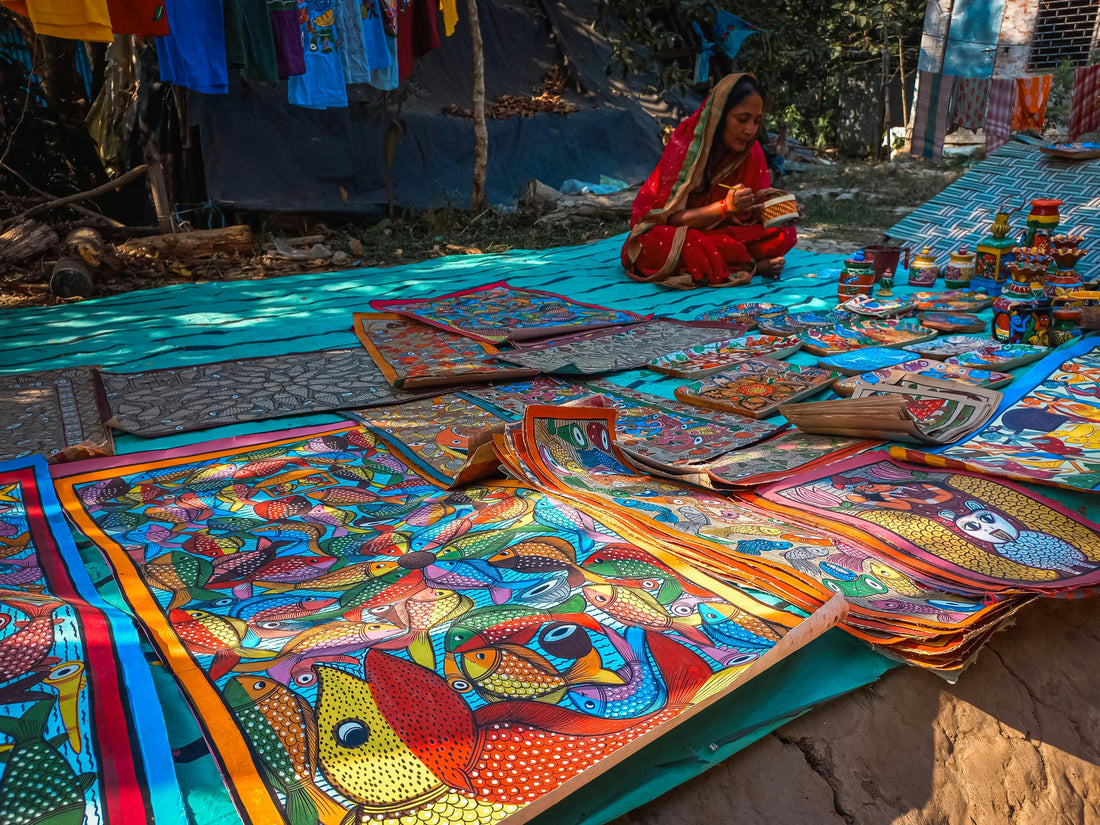
All About Indian Art and Craft
Share
Madhubani
Madhubani (or Mithila) painting is an ancient Indian folk-art that originated in the Mithila region of present-day Bihar. It is believed that the king of Mithila, Raja Janak commissioned the women of theregion to decorate the entire kingdom with beautiful wall murals for his daughter's wedding. This makes Madhubani paintings at least as old as the Ramayana, celebrating the union of Sita and Rama.The art-form survived through time and got famous as a form of wall art, practiced widely throughout the Mithila region.
Madhubani paintings are usually created using natural colours and depict deities in different forms,day-to-day activities of womenfolk, flora & fauna, animals, and birds. The distinguishing feature ofthis art form is the quintessential double-line that is used in all motifs. Madhubani paintings are abeautiful amalgamation of two different strokes called ‘Kachni’ and ‘Bharni’. While Kachni represents a repeated pattern that is used to fill up a motif, Bharni represents a motif that is filled with colour. There is no restriction on colours and Madhubani paintings are equally beautiful, whether in monochrome or filled with a thousand colours. During ancient times, motifs were restricted to Gods and Goddesses and but that’s not the case anymore. Many contemporary artists are attracted towards this ancient art form and they’re bringing in their own versions that are equally beautiful.
Railway Station at the sleepy old town of Madhubani is a tourist attraction in itself. With its amazing wall art, this one deserves a mention as an open art gallery, inspiring people in ways more than one. Every household in this town is trying to keep this art alive and retain olden practices that makes their work authentic (like using natural colours, hand-made paper, and nibs)
Pichwai
Pichwai is an art-form that originated in the Nathdwara region of the royal state of Rajasthan, at least 400 years ago. Located on the banks of the river Banas overlooking the Arawalis, this sleepy oldtown is known for its 17th Century Srinathji Temple, which is an abode of Lord Krishna, dedicated to his 7-year-old form. The word Pichwai originates from the Sanskrit word spich (behind)and wai (hanging). Pichwai paintings were first commissioned by the head priest for the Srinathji Temple to be hung as backgrounds in the inner sanctum of the temple, behind the idol of Krishna. These backgrounds were changed daily, in accordance with the seasons, festival and ‘tithi’. The devotees who were wealthy soon started commissioning their own Pichwai paintings, making this intricate art form popular and timeless. Today, Pichwai paintings are equally popular in India and abroad, making it the main export of Nathdwara.
Pattachitra
Pattachitra literally translates to a traditional cloth-based scroll painting. This beautiful art form has its roots in the eastern states of Odisha and West Bengal. Most ancient Indian art forms emerged as being dedicated to some or the other Indian God/Goddess and Pattachitra is no exception. This art form is closely related to Lord Jagannath and its typical characteristics being a mandatory floral border, elongated eyes, use of solid natural colours that make them vibrant and beautiful. A small artisan village called Raghurajpur is the epicentre of Pattachitra art today, keeping alive this 12 th Century art form by passing on the skills from generation to generation.
Sabai Grass
Sabai Grass, growing wild in the forests of Odisha and West Bengal first caught the attention of British who found it strong enough to make ropes for military purposes. Since then, it has been fashioned into many products, as vast as an artisan’s imagination. From baskets, pots, wall décor to even small-scale furniture, the possibilities are endless. An eco-friendly alternative that looks great, can be easily dyed to create vibrant products, Sabai Grass products are a lovely extension of the past into current times. Weaving has been an intricate part of Indian handicrafts, and these small villages are keeping the tradition alive along with innovating the products to match world-wide demand.
Blue Pottery
Blue Pottery originated somewhere in Mongolia and travelled eastwards to India with the Turks in the early 14 th Century. Originally used in the form of tiles to decorate mosques, tombs, and palaces in Central India, blue pottery had its own journey of sorts within India. From architectural tiles, it metamorphosed into beautiful artefacts and vessels created by Indian potters of the era. It is believed that blue pottery reached Jaipur through Delhi, which remains a hub of blue pottery till date. The distinguishing factor of blue pottery is that it is made from quartz, not clay which makes it more versatile. The ultramarine blue colour is created using Cobalt Oxide and motifs span from various flora and fauna.
Mudur Kati (Natural fiber)
Mudur Kati is a plant found in abundance in Medinipur region of west Bengal, which is used to make traditional mats. In fact, Mudur in Bengali translates to mats, which are an integral part of Bengali lifestyle. The origin of this handicraft dates to the 16 th Century and it still forms an integral part of rural economy of the area. These mats are traditionally woven by women and their innovation has led to many interesting products like bags, table mats, coasters, gift boxes etc. They are also used as a placeholder for religious purposes.
Brass
Brass Moradabad in UP , Bastar in Chhattisgarh and Bankura in West Bengal are the cities famous for Brass work in India. The items and designs include patterns that depict India’s rich history and culture. Products range from utility items as well as decorative items including utensils, trophies, jewellery etc. These items are handmade and portray a unique style that is peculiar to the region. The items from Chhattisgarh usually depict tribal elements while from Moradabad are inspired byHindu Gods and Goddesses or have an impact of Mughal patterns.
Woodwork
Saharanpur, UP is famous for woodcraft, which dates to about 400 years. The city embraced this craft during the Mughal era. It is believed that some artisans came from the Himalayan state of Kashmir, that is still famous for its woodwork, and settled in Saharanpur during the reign of Mughals. The influence of Kashmiri artists is still evident in the designs today, linking them back to where the first artisans came from. Sheesham wood is generally used to make these products with intricate carvings which are today exported all over the world.
